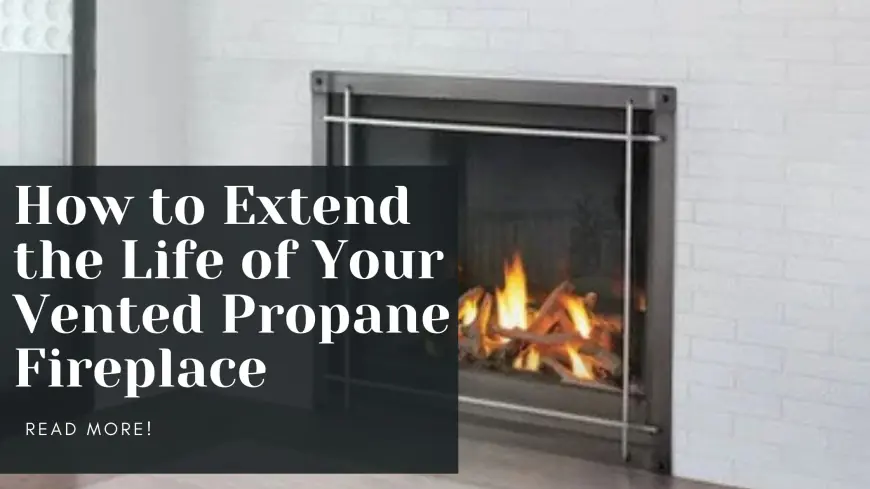How to Extend the Life of Your Vented Propane Fireplace
To ensure long-term performance and safety of your vented propane fireplace, focus on these essential maintenance steps: clean regularly, check for issues.

The allure of a cozy propane fireplace creates a centerpiece of comfort and ambiance. However, the longevity of your fireplace largely depends on proper maintenance. Neglect can lead to costly repairs and serious safety hazards. Statistics show that nearly 30% of all fireplace malfunctions are linked to lack of maintenance, often resulting in repair costs ranging from $100 to over $1,000.
Understanding the importance of maintenance can save you money and protect your home. This article will guide you through essential maintenance steps, including cleaning, inspections, and troubleshooting, ensuring your fireplace runs efficiently for years to come.
Understanding Your Vented Propane Fireplace
Components Overview
A vented propane fireplace consists of several key components:
-
Burner: Generates heat and flames when propane is ignited.
-
Log Set: Adds aesthetic appeal while distributing heat.
-
Pilot Light: Maintains a small flame, allowing for easy ignition.
-
Venting System: Expels combustion gases outside.
Identifying Potential Issues
Common problems can arise if maintenance is overlooked:
-
Pilot light issues: If it won't stay lit or keeps going out.
-
Burner malfunctions: Flames that are uneven or do not ignite.
-
Ventilation problems: Blocked vents that hinder proper airflow.
Safety Precautions
Before performing any maintenance, prioritize safety. Always turn off the gas supply and allow components to cool. Wear safety goggles and gloves to protect yourself from debris or sharp edges.
Annual Cleaning and Inspection
Cleaning the Burner and Log Set
Follow these steps to clean the burner and log set:
-
Turn off the gas and let the fireplace cool down.
-
Remove decorative logs gently.
-
Use a soft brush or vacuum to remove dust and debris from the burner and logs.
-
Wipe surfaces with a damp cloth.
Checking for Obstructions in Venting System
Inspect the venting system for blockages:
-
Remove any visible debris around the vent.
-
Use a flashlight to check for obstructions inside the vent.
-
Clear any blockages to ensure proper airflow.
Professional Inspection Recommendation
Scheduling an annual professional inspection can provide numerous benefits:
-
Thorough cleaning of all components.
-
Identification of potential issues before they become serious.
-
Assurance of safety and efficiency.
Maintaining the Pilot Light and Igniter
Troubleshooting a Pilot Light
If your pilot light malfunctions, follow this guide:
-
Ensure the gas supply is on.
-
Locate the pilot light assembly.
-
Follow the manufacturer’s instructions to relight.
-
If it won’t stay lit, check for draft issues or clogged components.
Igniter System Maintenance
To maintain the igniter system:
-
Inspect the igniter for dirt or rust.
-
Clean it gently with a soft brush or cloth.
-
Test the igniter to ensure it sparks properly.
Replacing Parts
Should you need to replace the pilot assembly or igniter:
-
Turn off the gas supply.
-
Remove the old part according to the manufacturer’s instructions.
-
Install the new part and test it for proper operation.
-
Source replacement parts from local hardware stores or online retailers.
Gas Line and Pressure Check
Checking Gas Line Connections
Follow this step-by-step guide to check the gas line:
-
Inspect all connections for tightness.
-
Apply soapy water to joints; bubbles indicate leaks.
-
Tighten loose connections and replace damaged lines if necessary.
Propane Tank Management
Manage your propane tank properly:
-
Store tanks outdoors in well-ventilated areas.
-
Keep away from heat sources and direct sunlight.
-
Regularly refill and check for any signs of wear.
Pressure Gauge Reading
Understanding pressure gauge readings is crucial:
-
A normal pressure reading is usually between 10-30 PSI.
-
Lower readings may indicate gas supply issues.
-
High readings could signal blockages or improper ventilation.
Preventative Maintenance Tips
Regular Cleaning Schedule
Follow this cleaning schedule for optimal performance:
-
Clean the burner and logs every 6 months.
-
Inspect the venting system annually.
-
Schedule professional inspections once a year.
Environmental Factors
Environmental factors can affect your fireplace:
-
Keep the area around your fireplace clean and dust-free.
-
Use dehumidifiers in damp environments to prevent rust.
-
Avoid placing fuel sources near the fireplace to minimize soot buildup.
Addressing Unusual Noises or Odors
If you notice unusual noises or odors:
-
Investigate immediately—these could indicate problems.
-
Shut off the fireplace and consult a professional if issues persist.
Conclusion
To ensure long-term performance and safety of your vented propane fireplace, focus on these essential maintenance steps: clean regularly, check for issues, and schedule professional inspections. The financial and safety benefits of regular upkeep cannot be overstated. Save yourself from costly repairs and ensure a warm, cozy home.
Schedule your annual fireplace maintenance today with Chimney Cricket to enjoy the warmth and beauty of your fireplace for years to come.

 dinojames
dinojames 










